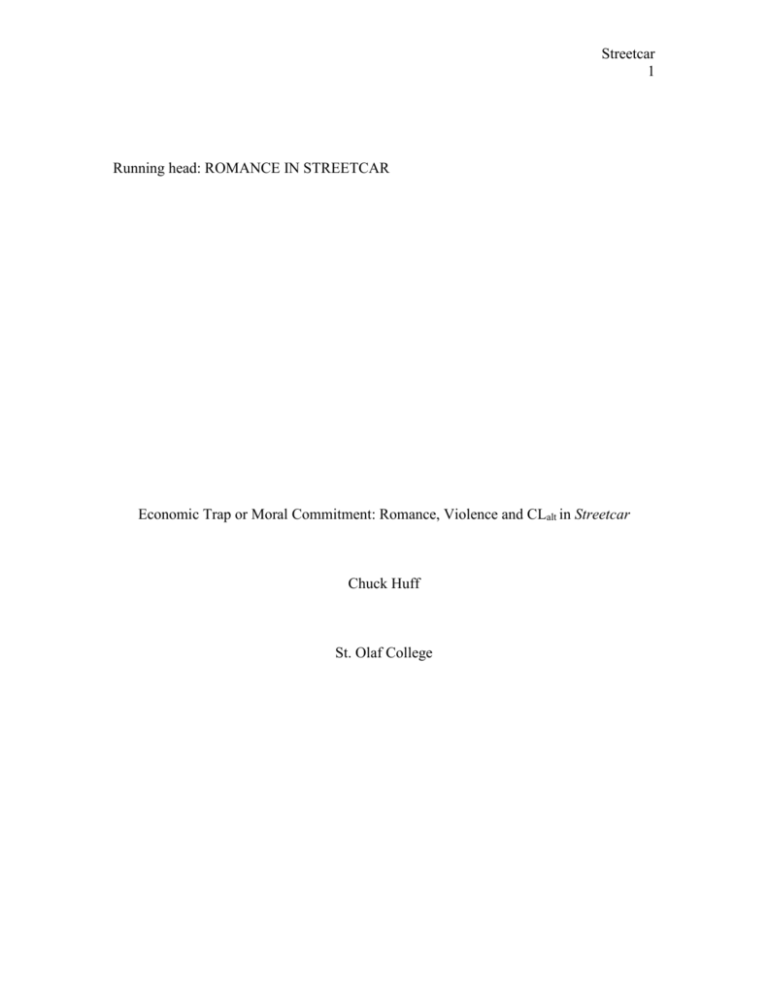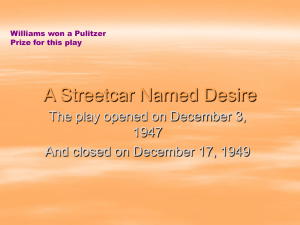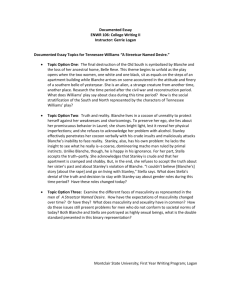example - St. Olaf College
advertisement

Streetcar 1 Running head: ROMANCE IN STREETCAR Economic Trap or Moral Commitment: Romance, Violence and CLalt in Streetcar Chuck Huff St. Olaf College Streetcar 2 Abstract The standard explanation for why abused women stay in an abusive relationship is that they feel they have no alternatives that are any better than their current relationship. This economic analysis of decision-making in relationships may do well in explaining most abusive relationships in the real world. Tennessee William’s (1947) play A Streetcar Named Desire, however, provides us a portrayal of another route to stability in abusive relationships. Stanley is abusive to Stella, but in William’s portrayal, she is also forgiving (to a point). At least early in a relationship, the role of romantic lover may create expectations and patterns of attribution that keep the victim in the relationship (personal communication, C. Huff, Sept. 2005). William’s (1947) play allows us to see the thinness of economic descriptions of relationships and the usefulness of more thick descriptions of social roles. Streetcar 3 Economic Trap or Moral Commitment: Romance, Violence and CLalt in Streetcar Tennesee Williams (1947) A Streetcar Named Desire is a classic portrayal of a woman trapped in an abusive relationship. (para will introduce play and plot, particularly Stanley and Stella). But a closer look will show that Williams (1947) has given us more complexity in the relationship. (para will show script quotes to portray S&S’s romantic love). A host of variables influence whether a couple stay together when things get difficult. Brehm et al. (2002) list actual outcomes, comparison level (CL) , comparison level for alternatives (CLalt)) investments, and moral commitment among these items. (para identifies the particular concepts chosen) These social science concepts allow us to name some of the subtlety that Williams (1947) presents in Stanley and Stella’s relationship. (para gives examples of the complexity of their relationship) An Introduction to the Concepts CL and CLalt Though it is not a romantic way to describe relationships, Brehm et al., (2002) make a convincing case that simply comparing expectations and outcomes can predict both satisfaction and dependence in a relationship. (para explains the two concepts, along with outcome as rewards - costs) Streetcar 4 Moral Commitment But more than a simple tallying may be involved in people’s commitments to their relationship. (para explains how moral commitment is different from simple cost and reward analysis). Romantic Love Another thing that may keep a couple together is the passion experienced in romantic love. In lecture (C. Huff, personal communication, Sept. 2005), Huff argues that in addition to being a passion that overcomes the lover, the role of lover is a socially constructed set of expectations that come with obligations (e.g. to public displays of affection). Thus, while the economic model might count the giddy feeling of romantic love as simply a reward, romantic love may also come with its own set of social expectations. And these expectations may constrain a lover’s behavior in addition to more economic indicators like rewards, costs, and CLalt. The social role of romantic love may, at least early in a relationship, require the lover to downplay the beloved’s shortcomings, forgive lapses, and idealize the beloved’s personality. It may also contribute to a couple’s making of benign attributions for each other’s lapses. In this way, at least early in a relationship, the social role of romantic lover may contribute to the longevity of the relationship. Cost, Reward, and Moral Commitment in Streetcar There are clearly both costs and rewards for Stella in the relationship (para presents costs: violence, restrictions, etc.) Stella’s initial attraction to Stanley was likely because of his clear physical attractiveness. (para presents other rewards for Stella, e.g. his good job). Streetcar 5 So is Stella happy in her relationship? It is not clear that the economic model can really tell us. She has likely lowered her CL considerably in taking Stanley as a husband (at least Blanche thinks so). But often she appears quite happy with Stanley, and clearly in love. If we take this lowered CL and compare it to the costs and rewards, this blunt analysis makes it seem possible she is, on average, happy in her relationship with Stanley. But “on average” covers a multitude of variation. Stella and Stanley’s relationship is constantly swinging from one extreme to another. One moment they are hugging contentedly, the next, Stella is cowering or running away. William’s portrayal of these swings allows us to see the complexity of their relationship. And the economic model is a poor measure of that complexity: it is too abstract to catch the real pleasure and pain of the Kowalskis. But even if she were unhappy, can she leave? (para does CLalt and dependence in Stella) Still it is possible that Stella’s computations are not about rewards and costs, but about her moral commitment to their relationship. (para presents evidence for this) But it is also possible that all this evidence of moral commitment is just Williams’ (1947) portrayal of the short-sightedness of romantic love. (para provides script evidence of romantic love and speculates on age of S&S relationship, and whether falling out of love is also a social role) Williams (1947) clearly leaves us without enough information to decide Stanley and Stella’s fate as a couple. (concluding para about thinness of economic model and value of less abstract descriptions, like the complexity of roles) Streetcar 6 References Brehm, S. S., Miller, R. S., Perlman, D., & Campbell, S. M. (2002). Intimate relationships. New York: McGraw Hill. Williams, T. (1947). A streetcar named desire. New York: New Directions.






